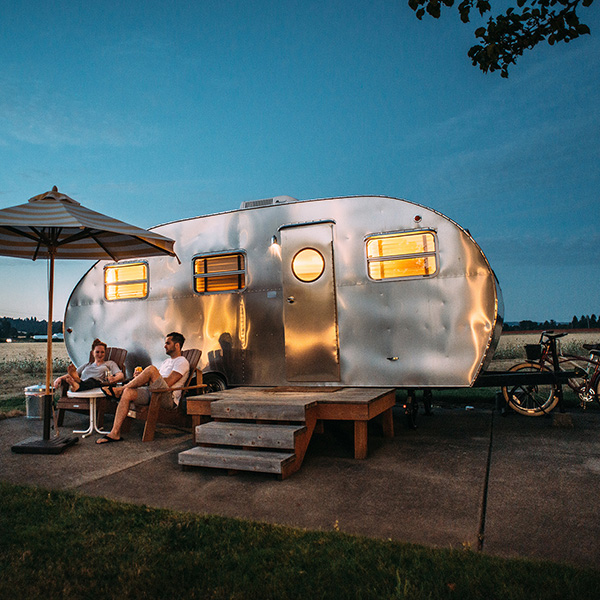“COVID Campers” and Bikes in High Demand
By Jeanette Prather
 Maybe you’ve seen it for yourself on the road or read it in a newspaper, but if not, you’re about to be clued in. Amid the COVID-19 pandemic, there has been a noticeable surge in RVs (the blanket term meaning ‘recreational vehicle’ and classifying all motorhomes, towable campers, fifth wheel campers, and truck campers) as well as bicycle sales around Santa Cruz and across the nation.
Maybe you’ve seen it for yourself on the road or read it in a newspaper, but if not, you’re about to be clued in. Amid the COVID-19 pandemic, there has been a noticeable surge in RVs (the blanket term meaning ‘recreational vehicle’ and classifying all motorhomes, towable campers, fifth wheel campers, and truck campers) as well as bicycle sales around Santa Cruz and across the nation.
“Without a doubt we’ve been feeling the recent surge in RV sales,” said Santa Cruz’s North Bay Ford RV manager Joe Punzi on his way to an RV showing. “It’s always been a challenge to find good quality used inventory, but especially now when I do it doesn’t last more than a few days. That’s been the trend.”
According to the RV Industry Association and a private study conducted by the Kampgrounds of America (KOA), 34 percent of US and Canadian campers believe that road trips will be the safest mode of travel even after stay-at-home orders are lifted, which the RV Industry Association predicts will boost the number of American road travelers to 46 million by next year. “The RV Industry Association also found that 20 percent of US residents surveyed have become more interested in RV travel than flying, tent camping, cruises, and rental stays amid coronavirus concerns,” wrote Brittany Chang of the Business Insider on June 13.
In the beginning of June, Santa Rosa RV who typically sells an average of six RVs per week, sold a record 22 in one week, which is more than they sell in one month, according to an ABC7 news report. “In general, dealers tell [ABC7] that sales have doubled. It’s a seller’s market driven by a shortage of units after COVID-19 closed the RV factories,” reported Wayne Freedman.
RV sales are not the only ones seeing a dramatic increase. Somewhat unrelated but equally as relevant, bicycles have grown more popular.
“I called Scotts Valley Cycle Sport to get my son’s bike wheel fixed, and they gave me an appointment one month later saying that they were all backed up until then,” local father, Eric Bent commented.
“We’ve definitely seen an increase in bike sales and bike orders by about 200%,” said Scotts Valley Cycle Sport’s sales manager, Caro Gomoz-Villafane. “We weren’t busy at all the first and second weeks of the COVID shelter-in-place orders, but then suddenly it’s been a pretty stable increase in demand. So much that we opened a full warehouse and hired 12 bike builders to meet the demand.”
Gomoz-Villafane said that aside from an inventory dip prior to Cycle Sport opening their warehouse, they’ve been very fortunate not to suffer through a lack of inventory leading to a lack in sales, which she mentioned some other bike shops have experienced. “For a while before we opened the warehouse, our sales floor was pretty bare, but the idea is to keep up the demand in sales, so we started to build more bikes,” said Gomoz-Villafane. “Overall, we’ve been very lucky and have staff with great attitudes and high spirits.”
One bicycle service technician named Ian from Bicycle Trip in Santa Cruz, mentioned that they were so busy and backed up with bikes that he didn’t have time to stop for questions. “Correct, we’re that busy, which is good” he said, “but I’m just that backed up.”
A Los Angeles Times article in June mentions protests as one of the reasons the Bay Area can’t keep stocked. There is, of course, the physicality during SIP orders and a growing tension with mass travel in the face of COVID-19.
“In the Bay Area, families are inundating roads with cycling outings,” the article, titled “Bicycles have enjoyed a boom during the pandemic. Will it last as car traffic resumes?” According to PeopleForBikes data, bike sales were up substantially from last year — 65 percent greater than year-to-date 2019,” the article said.
With the astronomical demand in bicycles since the COVID pandemic, bike manufacturers have needed to (2020 catch phrase alert!) ‘pivot’ their manufacturing tactics. According to Medium.com writer Larry Kanter, the second-largest bicycle manufacturer in the world, Trek, is trying to set the trend in meeting demand on the supplier’s level. “[CEO John Burke] and his team drilled deep into Trek’s vast supply chain, gauging the capabilities of suppliers, in most cases doubling its orders for handlebars, frames, wheels, and other components,” wrote Kanter in an August 3 article on Meduim.com titled, “Inside the Company Trying to Solve the Global Bicycle Shortage.”
In addition to numbers forecasting that helped conversations with overseas suppliers, Trek turned to small bike retailers and helped them curate a tailored experience for their customers, essentially ensuring the customers were treated with utmost care and service. “This is not a blip,” Burke told Kanter. “People want to be outdoors. They want to exercise and they want transportation that’s not a bus, a train, or a trolley. You have this massive issue of climate change — and consumers actually wanting to do something about it.”
With personal travel and vacation transportation booming, suppliers and retailers well positioned to handle the surge will side-step the rest of the economic recession. Airplanes, cruise ships and buses might remain empty for now, but bicycles and recreational vehicles are all the rage with no sign of slowing down.
“I’ve worked in the bike industry for 13 years and have never seen anything like it,” said Gomoz-Villafane. “I don’t think it’s going away anytime soon.”







